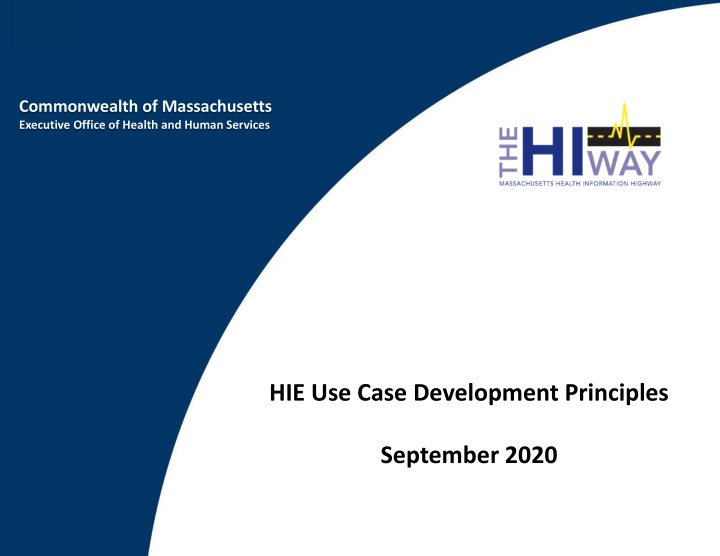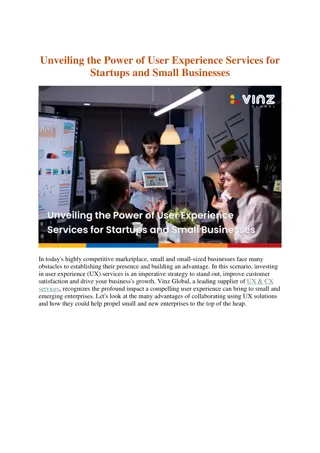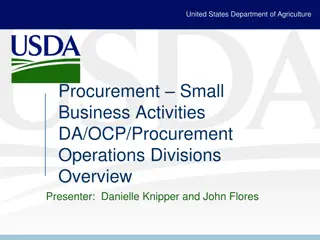Small Business Research Overview
This content delves into the landscape of small business lending in the U.S., focusing on Section 1071 of the Dodd-Frank Act and its implications for data collection on women-owned, minority-owned, and small businesses. It explores key dimensions of the small business lending marketplace, including financing sources, market size, and ownership demographics. The overview also highlights the statutory data points required under Section 1071 and outlines the current status of rulemaking efforts regarding the implementation of this regulatory requirement.
Download Presentation

Please find below an Image/Link to download the presentation.
The content on the website is provided AS IS for your information and personal use only. It may not be sold, licensed, or shared on other websites without obtaining consent from the author.If you encounter any issues during the download, it is possible that the publisher has removed the file from their server.
You are allowed to download the files provided on this website for personal or commercial use, subject to the condition that they are used lawfully. All files are the property of their respective owners.
The content on the website is provided AS IS for your information and personal use only. It may not be sold, licensed, or shared on other websites without obtaining consent from the author.
E N D
Presentation Transcript
Commonwealth of Massachusetts Executive Office of Health and Human Services HIE Use Case Development Principles September 2020
Learning Objectives Communicate the benefits of a Use Case Identify a Use Case scenario / user story Develop a Use Case with recommended elements 2
Topics Use Case Introduction Elements of a UseCase Development Guidance Use Case Examples Key Takeaways 3
Use Case Introduction What is a Use Case? A well-crafted Use Case is an easy-to-understand description that details the interaction between an actor (human, organization, system) and a system under consideration For HIE purposes, a Use Case identifies Trading Partners, Source and Destination systems, and the intended use of HIE Why do we utilize Use Cases? Use Cases are developed with a goal in mind, which makes them a valuable planning tool A Use Case communicates the functional requirements to inform the technical planning Having Use Cases available prior to technical discussions helps scope the technical solution and accelerates the technical evaluation process 4
Use Case Introduction How do Use Cases assist in implementing HIE? Understand the business need early on in the process Issue you seek to resolve, or opportunity on which you intend to capitalize Define specific goals and objectives For instance: I need to join the HIway Lacks specificity Our Practice needs to securely send summary of care records to my patients specialists to improve care coordination and avoid delays Our Practice needs to generate and securely send summary of care records to my patients specialists to meet MU2, Transition of Care criteria. Provides initial needed details to guide plan development, scope the effort, and establish priorities Accelerate the development and implementation Define a basis for measuring and evaluating success 5
Use Case Context for HIway Connection A key milestone onthe HIway connection path 6
Use Case Benefits Identifies the clinical and business needs before starting the development of the solution, which avoids rework and delays Facilitates initial scoping, project planning, and prioritization Supports "selling" your request to management Do your due diligence to articulate value and the right functionality Supports identifying the project team and stakeholders 7
Next Topic Use Case Introduction Elements of a Use Case Development Guidance Use Case Examples Key Takeaways 8
Use Case Elements Use Case name Goal Summary overview Story Trading Partners Important detail Systems Data to exchange 9
Use Case Elements (Summary overview) Use Case name Brief summary of your Use Case (limit to 100-characters) Example: Patient referral from PCP to Specialist Goal What you want to accomplish Example: To improve care coordination To reduce delays in care To reduce errors in patient information 10
Use Case Elements (Summary overview) Story Description of how you intend to use HIE Perspective > A provider referring a patient to a specialist Context > The referring provider has made the determination that it is clinically and legally appropriate to send a referral and summary of care to the specialist. Story Dr. Jones, the referring provider, searches for a patient in the practice s EHR and initiates a referral message. The referral reason is described in the message. In some cases the referral is directed to a specific specialist, and in other cases to a specialist practice. Dr. Jones attaches a summary of care for reference, and then sends the referral. Dr. Smith, the specialist, sees the new referral in her local practice EHR. If this is a new patient for the practice, a new patient is created in the EHR. The core referral and the various documents are imported into the new patient's chart. Reference: The Direct Project, User Stories http://wiki.directproject.org/Primary+care+provider+refers+patient+to+specialist+including+summary+care+record 11
Use Case Elements(Important details) Trading Partners The senders and receivers of health information People, roles, specialty, organizations: People = Dr. Jones, Nurse Thompson Roles = Case Manager, Triage Nurse Specialty = Oncology Specialists, Primary Care Organizations = Hospital ABC, Medical Associates of XYZ When describing the organization include relevant information such as number of beds, providers, visits per month. Source, destination, and intermediary systems (e.g. EHR, HIE) When describing systems include vendor names and versions Data to exchange The data you intend to exchange 12
Selecting Trading Partners Potential Trading Partners for HIE Use Case Select external care providers who you frequently interact with to provide care for the same patients Select Use Cases where HIE can have a significant impact on improving the care of these patients Discuss with these providers whether they already have HIE, or are willing to implement an HIE solution Visit the HIway Connections Map to view potential trading partners who use the Mass HIway: https://mehi.masstech.org/education/mass-hiway-directory 13
Example Data Sets CCD (Continuity of Care Document) Commonly used type of electronic document that summarizes patient information and helps providers communicate clinical information via HIE during transitions of care 1. Patient name 2. Sex 3. Date of birth 4. Race ** 5. Ethnicity ** 6. Preferred language 7. Care team member(s) 8. Allergies ** 9. Medications ** 10. Care plan 11. Problems** 12. Laboratory test(s) ** 13. Laboratory value(s)/result(s) ** 14. Procedures ** 15. Smoking status ** 16. Vital signs Meaningful Use Data Set Minimum data that needs to exchanged to meet the Meaningful Use HIE objective NOTE: Data requirements marked with (**) have a defined vocabulary which must be used. 14
Next Topic Use Case Introduction Elements of a UseCase Development Guidance Use Case Examples Key Takeaways 15
Use Case Guidance Limit the Use Case overview to 1-2 page(s) Engage your clinical and business leaders early Align to business and clinical objectives Complete the identified elements in 2 phases: Phase 1: Name, Perspective, Context, Story Phase 2: Trading Partners, Systems, Data to Exchange Tell the story of how you will use the solution once built Do not describe technical connectivity (i.e. S/MIME vs. XDR) Make the Use Case specific Select a well-defined area of focus and add in appropriate detail 16
Next Topic Use Case Introduction Elements of a UseCase Development Guidance Use Case Examples Key Takeaways 17
List of Use Case Scenarios Use Case Type of Transaction Care Setting To Care Setting 1.1 Referral -- Summary of care record PCP Specialist 1.2 Consult note -- Summary of care record Specialist PCP 2.1 Referral -- Summary of care record PCP or specialist Hospital 2.2 Hospital admission notification Hospital Referring physician and/or PCP 3.1 Hospital ED visit summary Hospital Referring physician and/or PCP 3.2 Hospital discharge summary Hospital Referring physician and/or PCP 3.3 Hospital discharge summary Hospital Other care settings (i.e. SNF) 4.1 Hospital admission notification Hospital Referring Hospital 4.2 Hospital discharge summary Hospital Hospital 5.1 Public Health Reporting PCP or specialist Public health 5.2 Public Health Reporting Hospital Public Health 18
Scenario 1.1 Referral Care Coordination Provider to Provider Referral HIE PCP Specialist Consult Note Patient Scenario Specialist A. Receives Direct Message with summary of care document 1. Patient seesPCP 2. PCP s plan includes a referral to a Cardiac specialist B. Provides necessary care 3. Referral to specialist is generated with a summary of care document and attached to a Direct Message C. Generates a consult note for delivery to PCP D. Consult note is attached to a Direct Message and sent via HIE to PCP 4. Direct Message is sent via HIE to Cardiac specialist 19
Scenario 2.1 Hospital Referral Care Coordination Hospital to Provider / Provider to Hospital Specialist HIE PCP Patient Scenario Hospital A. Receives the Direct Message with the referral and summary of care document 1. Patient sees PCP orspecialist 2. Treatment plan includes a referral to a local hospital B. Provides necessary care 3. Referral to hospital is generated with a summary of care document and attached to a Direct Message C. Generates an admission notification and summary of care document D. Admission notification is sent via HIE to PCP and/or specialist 4. Direct Message is sent via HIE to hospital 20
Scenario 3.1 ED Notification Specialist HIE PCP Patient Scenario Hospital A. Provides necessary care 1. Patient presents at Emergency Department B. Generates an admission notification and summary of care document 2. Patient is treated andreleased C. Admission notification sent via HIE to PCP and/or specialist 21
Scenario 3.2/3.3 Discharge Summary The image cannot be displayed. Your computer may not have Specialist HIE PCP The image cannot be displayed. Your computer may not have SNF Patient Scenario Hospital A. Provides necessary care 1. Patient is discharged from hospital to the care of a referring physician, PCP or other care setting B. Generates a discharge summary and summary of care document C. Discharge summary is sent via HIE to referring physician, PCP, and/or other care setting 22
Scenario 4.1/4.2 Referral HIE XYZ Hospital ABC Hospital XYZ Hospital ABC Hospital 1. Patient admitted to XYZED A. Patient is received at ABC hospital B. ABC hospital receives Direct Message with referral and summary of care document 2. Treatment plan calls for a tertiary level of care 3. Patient is referred to ABC hospital C. Provides necessary care 4. Referral and summary of care are generated and attached to a Direct Message D. Generates a discharge summary and summary of care E. Sends discharge summary and summary of care via HIE to XYZ hospital 5. Direct Message is sent via HIE to ABC hospital 23
Public Health Use Cases Dept. of Public Health PCP Immunization Reporting Electronic Lab Reporting Syndromic Surveillance CANS Assessments (CBHI) 24
Next Topic Use Case Introduction Elements of a UseCase Development Guidance Use Case Examples Key Takeaways 25
Key Takeaways Develop Use Cases to: Identify clinical and business needs before solution development Develop the goal and objectives Communicate clinical, business, and functional requirements Facilitate initial scoping, project planning and effort prioritization Elements of a Use Case include: Use Case name Goal Story Trading Partners Systems Data to exchange Summary overview Important detail 26























